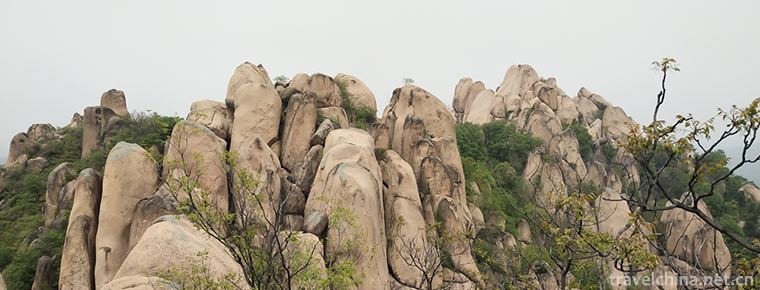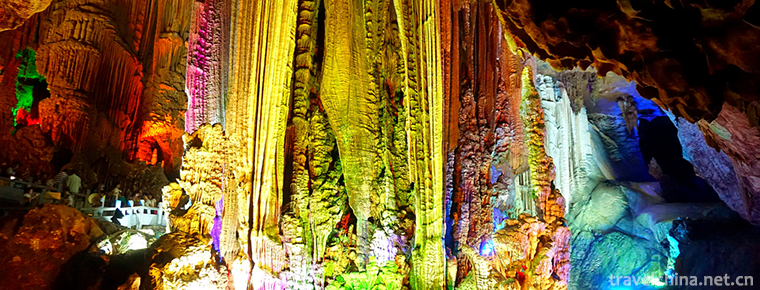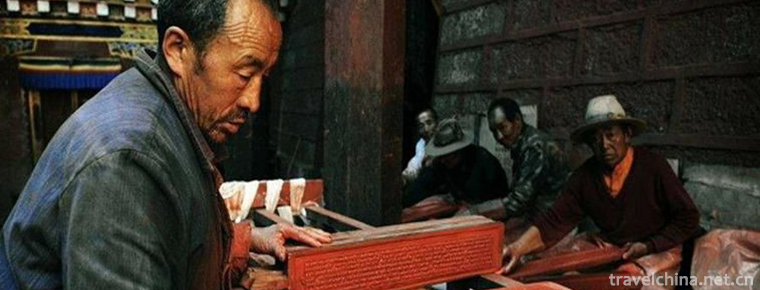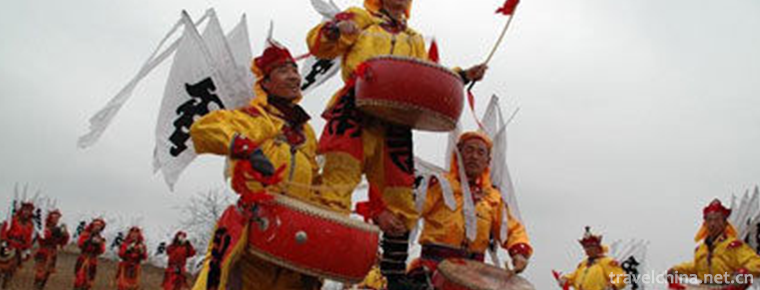Asihatu Stone Forest
Chaihe Tourist Scenic Spot has a total area of 1368.7 square kilometers, which is a national 5A tourist scenic spot. The area of Alshan City in Xing'an League is 7408.7 square kilometers, and Chaihe Town in Zhalantun City, Hulun Bell is 5760 square kilometers.
On February 25, 2017, the Alshan Chaihe tourist attraction was newly promoted to the 5A national tourist attraction.
geographical position
Alshan is a border city in the eastern part of Inner Mongolia. It spans the southwestern foothills of Daxing Mountains. Its geographic coordinates are 119 28'- 121 23', and 46 39'- 47 39'. Chaihe Town is situated 185 kilometers southwest of Zhalantun City. Its geographical coordinates are 120 degrees 36'-121 degrees 46', 47 degrees 05'-47 degrees 45'. The Alshan-Chaihe scenic spot belongs to the ridge of the middle section of the Great Hinggan Mountains, with an average elevation of 1100 meters. It belongs to the continental climate of the cold temperate zone. The annual average temperature is - 3.1 C, the coldest monthly average temperature is - 25.6 C, and the highest temperature is 16.6 C. The annual average precipitation is 460 mm. The vegetation coverage is 95% and the forest coverage is 64%. It belongs to the cold temperate coniferous forest in the northern hemisphere. Alshan, known as "Harun Alshan", is a Mongolian language, translated into Chinese meaning "hot holy water", is a tourist resort city named for water and prosperous because of springs. The population of Chaihe Town in Alshan City and Zalantun City is 64,000. It is a multi-ethnic inhabited area composed of 13 ethnic groups including Mongolia, Han, Hui, Manchu, Korea, Daur, Ewenki, Oroqen, Menba and Xibo.
The Alshan-Chaihe scenic spot is located in the core of the economically developed areas in eastern Inner Mongolia. It has convenient transportation with the surrounding cities. It has the strategic position of integrating the tourism resources of Manzhouli, Hailar, Zhalantun, Ulanhot and Xilinhot to construct the golden tourism area in Inner Mongolia. At the same time, Alshan City is located in the hinterland of Northeast Asia Economic Circle and the West export of Northeast China Economic Zone. It is adjacent to Mongolia in the West and has a border line of 93.531 kilometers. According to the demonstration and planning of the United Nations Development Programme, the railway from Alshan to Qiaoba Mountain in Mongolia can be built to form the East Tumen, Mongolia and Russia in the west, and the New Eurasia Continental Bridge connecting the whole Northeast Asia will be formed. This "bridgehead" of the Eurasian Continental Bridge is very important in its economic and geographical position.
climatic conditions
Alshan City is located in a special geographical environment, and its altitude gradually increases from southwest to northeast. It is mainly affected by the warm and wet air currents in the southeast ocean and the dry and cold air currents in the northwest. It belongs to the continental monsoon climate in the cold temperate zone, and is also located in the continental alpine climate area. The local microclimate characteristics are obvious. The annual temperature is lower, the frost-free period is short, the annual temperature is worse and the daily temperature is worse.
Four seasons characteristics
Alshan City has a unique four-season characteristics, that is, spring and autumn are connected, summer characteristics are not obvious, winter is long and cold. The seasonal variations of light, heat, water and wind are obvious.
From spring to autumn, the average starting date of spring is May 6, the average ending date of autumn is September 20, and the spring and autumn lasts about 138 days. In spring, the temperature rises rapidly, the daily temperature difference is large, the alternation of warm and cold air is frequent, and occasional snowfall and "late spring cold" phenomena occur. The precipitation variability is large, and the occurrence of spring drought is low. The number of gale days increased. The highest temperature occurs at 7 o'clock in the whole year. Meanwhile, precipitation increases, water vapor is abundant, heavy rain, hail and other severe convective weather occurs frequently, which endangers crops. However, the same season of water and heat is also the peak season for crop growth. From late August to mid-September, the temperature dropped obviously, the precipitation decreased obviously, the temperature difference between morning and evening was large, and the autumn frost appeared accordingly. The frost-free period of the year is about 90 days.
Winter in Alshan City is long and cold. The average starting date is September 21, and the average ending date is May 5, which lasts for more than seven months (227 days). Due to the influence of the northwest cold air and the control of Mongolian high pressure, the cold air mass stays for a long time, and there are many cold waves and snowstorms. The cold period lasted for more than three months and the snow cover period was 152.2 days. The winter snow amount averaged 30 mm, accounting for 6.5% of the annual precipitation. The extreme minimum temperature was - 45.7 C, which appeared on January 19, 1966. Occasionally there is a strong wind.
sunshine
The total solar radiation in Alshan City is 5275 MJ/m2, and the total radiation in crop growing season accounts for 66-69% of the annual value. The annual sunshine number is 2468 hours, and the average annual sunshine percentage is 56%. The monthly distribution of sunshine is the largest in May, with an average of 255.3 hours, and the smallest in December, with an average of 140.1 hours.
Temperature and humidity
The temperature difference between North and south is large in Alshan City, and there is a great difference between winter and summer. The annual average temperature is -3.1 C. The temperature in Wuchagou, Xikou and Mingshui areas south of Baiwolf area is increasing, while that in the north of Baiwolf area is lower. The coldest monthly mean temperature in Alshan City is -25.6 C, and the highest temperature is 16.6 C. The accumulated temperature is 1898.5, 1738.3, 1345.9 and 520 respectively above 0, 5, 10 and 15.
The water pressure in Alshan City decreases with the increase of sea level. It is the largest in summer and the smallest in winter, with an average annual mercury column of 5.3 mm. It is the lowest in Xing'an League. Relative humidity is higher than other parts of the League, with an average annual humidity of 70%. Every year from July to August is the largest, about 80%, about 50% in spring and 76% - 79% in winter.
precipitation
The annual average precipitation in Alshan City is 445.3 mm. The annual precipitation is concentrated in July and August, accounting for about 47% of the whole year. The snowfall in winter is 36.8 mm, accounting for 6.7% of the total annual precipitation, which is about 4.5% more than that in other parts of the League. The precipitation variability is relatively stable, showing that it is large in spring and autumn and small in summer and winter.
pressure
In winter, the air pressure in Alshan City is mostly controlled by cold high pressure. The air pressure is high in winter and low in spring and autumn, with an average of 898.3 hPa in January and 890.3 hPa in July. The average air pressure is 895.3 hPa, which is about 100 hPa different from the lowest elevation of Baoan Marsh in Xing'an League.
wind power
Alshan is a temperate continental monsoon climate. Affected by Northwest Airflow in winter, northwest wind and westerly wind are prevalent; southeast wind is prevalent in the intersection season of spring and autumn due to Southeast monsoon; the average annual wind speed is less than 2.7 m/s, which is the smallest area in Xing'an League.
Main attractions
Heaven Pool
Tianchi is located in Tianchiling, 74 kilometers northeast of Alshan City, at an altitude of 1332.3 meters, lower than Baitoushan Tianchi in Jilin Province and Bogda Peak Tianchi in Xinjiang Tianshan, which is the third highest Tianchi in China. Tianchi Lake is a volcanic crater lake formed by accumulated water in the volcanic crater after volcanic eruption. Because the water in Tianchi Lake is neither injected by rivers nor discharged by rivers, it forms a closed special type of crater lake-Mar Lake. Maar is formed by the explosion of the interaction between magma and water and gas. The crater wall around Maar Lake is usually several meters to tens of meters high and the top is relatively flat. The lake water is clear and calm, and the water depth is tens of meters. Some lakes are dry Maar Lake without water. Tianchi is one of the seven large and well-preserved lakes in Alshan. Tianchi is oval, 450 meters long in East and west, 300 meters wide in North and south, with an area of 13.5 hectares. The lake is dry for a long time, and the rain is not overflowing. The level is like a mirror. Tianchi has beautiful scenery. Green hills and trees are reflected in the clear water. The lakeside is surrounded by ancient pine trees, surrounded by purple and red mountain flowers, with a thousand meteorologies.
Shi Tang Lin
Shitanglin is located in the east of Tianchi, 84 kilometers away from Alshan City, and is one of the wonders of Daxing'an Mountains. Walking into Shitanglin is like walking into the natural and complete volcanic rock museum, where there are geological relics formed by many volcanic eruptions during the Quaternary Period. The volcanic eruption magma covers the ground and forms a vast lava mat and lava quilt. Lava above the ground often forms platforms. Lava turtle-back structure has also been found in a large area of volcanic lava landform. According to scientific research experts, it is the only large-scale, well-developed and well-preserved lava structure in China. Among them, lava mound is the only basalt landform that can be seen here in China at present.
Rhododendron Lake
Located 92 kilometers northeast of Alshan City, Rhododendron Lake covers an area of 128 hectares. It is named for the Rhododendron blooming all over the lakeside. The lake is L-shaped, with an inlet in the southeast and an outlet in the southwest. The upper part is connected with Songye Lake and the lower part is connected with the Haraha River. The average water depth is 2.5 meters and the deepest part is more than 5 meters. It is a mobile live water lake. Rhododendron Lake is a lake formed by volcanic lava blocking up the river channel, while Tianchi Lake, only 14 kilometers away, is a lake formed by volcanic crater water. The former is called barrier lake, while the latter is called crater lake. There are two types of lakes formed by volcanic action in the Alpine region. Liu Jiaqi, a volcano expert, said, "It is rare for a volcanic lake like Alshan to have crater lake, Mar lake and barrier lake." The environment in the area is quiet and the scenery is pleasant. When spring returns to the earth, the dense azaleas on the lakeside blossom in full bloom. The lake surface is shining like brocade and satin, and the clouds are more beautiful than fire. In the lake, wild raccoons, grey cranes and swans live in groups, and willow-root fish compete to feed; flowers and trees alternate along the lake, red and green are distinct; in summer, aquatic weeds sway in the wind and fragrant on the lake. In autumn, the water is as clear as a mirror, and the fish spin. The Rhododendron Lake in winter is a natural skating rink.
Pine leaf Lake
Songye Lake, formerly known as Darbin Lake, is located 10 kilometers southeast of Rhododendron Lake, 12 kilometers away from Xing'an Forest Farm, 102 kilometers away from Alshan City, covering an area of 314 hectares. It is the first of the barrier lakes in Alshan. Songye Lake flows northward through the Xiaohe River of No. 8 Valley into the Rhododendron Lake. The lake is 1300 meters long in North and south, 150 meters wide in East and west. Looking from north to south, the lake is meniscus-shaped, with continuous water and sky. Mountains lie on both sides of the East and west, and Termei, the second highest peak of Mount Alpine, lies on the southwest side of the lake at an altitude of 1711.7 meters. A fire tower is expected to be built on the hill. At the southern end of the lake, there is a small waterfall about 5 meters high. Songye Lake has flat bottom, wide lake surface, beautiful water quality and abundant wild fish. The lake shore is steep and steep, with dense virgin forests. Every autumn, the dense Larch needles floating down the lake, golden. It maintains the original mountain flavor and wild interest, which is a good place for seeking seclusion, novelty and boating.
Luming Lake
Luming Lake is a lake formed by the Haraha River blocked by volcanic lava flow. The original name is Bubble No. 3, 3 kilometers from Xing'an Forest Farm. The lake is about 1190 meters above sea level and has a wide surface with an area of 157 hectares. The Haraha River flows in from the southeast of the lake and flows out from the southwest end of the lake. The lake is rich in water and grass. The Luming Lake is surrounded by mountains on three sides. It is very quiet. Deer herds often appear and play, so it is called Luming Lake.
Wusu Langzi Lake
Wusu Langzi Lake is a lake formed by volcanic eruption lava flow blocking the Haraha River. Its original name is Bubble 49. Its water area is 135 hectares, with an average depth of 2.5 meters. It is surrounded by mountains. The water surface is like a mirror, and the water quality is beautiful. It is rich in cold water fish such as carp and white fish. According to the morphology and regional distribution of Wusulangzi Lake, it may also be a crater lake formed by volcanic eruption.
Forest of pine
Pinus sylvestris var. mongolica forest belongs to the southern end of the Pinus sylvestris forest belt on the west slope of Daxing'an Mountains. Pinus sylvestris var. mongolica forest is a vegetation developed under a specific ecological environment. It grows rapidly, has strong adaptability, and has good wind-proof and sand-fixing effect. There are dense forests, erect trunks, tall and deep twigs and intertwined roots. In the midsummer season, the canopy shelters the sun and the scenery is deep.
San Tan Gorge
Santan Gorge is located in the upper reaches of the Haraha River, 78 kilometers northeast of Alshan City. The riverbed is composed of rocks of different sizes. The turbulent Haraha River passes through the valley. The pearl flying jade rolls. The 3 km long valley is successively distributed in deep and unfathomable water. There are three pools of water, namely, the sleeping cattle pool, the tiger stone pool and the Yuexintan pool. Volcanic rocks are covered with valleys, and people can walk through rocky water. The south wall of the valley is steep and steep, while the north wall is formed by huge volcanic rocks. Rhododendron blossoms are everywhere on both sides of the canyon. Walking into this canyon gives people a sense of fairyland. Some people praise the Three Pools Gorge: magical and beautiful Three Pools Gorge, with clear springs rolling around the cliffs. Where does the Pearl splash the jade, the soul is far away from the East China Sea home. This section of the river still has snow and ice in June, known as the "summer glacier".
Haraway River
The Upper Source of the Ulson River in the Harbin River System is the boundary river between China and Mongolia. It belongs to the Erguna River System. It originates in the southeast mountain of Wudaogou in the northern part of the Motianling Mountains at the Western foot of the Great Hinggan Mountains. The Upper Source is converged by the three rivers of Xingan, Tianchi and Nangou. After the outflow of the Darbin Lake, the Suhu River and Gurban River flow into the river from east to west to 77 kilometers, respectively, and then converge to the southwest of Irshi. After the water of the Alshan River, a river with a depth of 1-1.5 meters and a width of 150 meters flowed northwest to 14 kilometers west of Cheqiuxi. It joined the Numulgen River at the border between China and Mongolia, then left the country, flowed through Mongolia, and finally into Lake Bell. It is 399 kilometers long and 135 kilometers long. It is a good place for fishing and drifting.
tourist resources
Mineral resources
Alshan Mineral Spring is one of the largest functional mineral springs in the world. According to the volcanic scientific examination conducted jointly by the Chinese Academy of Sciences and China University of Geosciences, there are more than 100 mineral springs with different temperatures and functions, such as cold springs, hot springs, hot springs and high hot springs, around Alshan Mountain. Among them, there are 48 mineral springs which can treat eight systemic diseases such as cardiovascular and cerebrovascular diseases, skin diseases and arthritis in the national AAAA scenic spot-Alshan hot spring sanatorium, which is 70 meters wide and 500 meters long. The other mineral springs are concentrated in Jinjianggou and Yinjianggou. Its medical function has been widely recognized by the medical community. Wuliquan Mineral Spring, located in Wuhuali City Center, is a natural and high-quality drinking mineral water, rich in trace and macro elements such as lithium, strontium and selenium, which gushes 1054 tons per day. It is praised by mineral water experts as "the first peculiar spring in the world". According to the Chinese Preventive Medicine Association, there are no cases of cardiovascular and cerebrovascular diseases and cancer among the residents in Alshan area.
Ice and snow resources
Due to the special geographical environment, the Alshan-Chaihe scenic spot is covered with snow and ice from November every year to April the following year, with thousands of mountains piled with jade and thousands of fields covered with silver. It has a long period of snow, good quality of snow, and the average thickness of snow is over 350 mm. With the special mountain topography, it is suitable for all kinds of skiing sports. In recent years, standard competitive ski resorts (including freestyle, cross-country and winter) and recreational ski resorts have been built successively in Alshan City. The famous Austrian skiing expert who visited China, Opez, praised the snow resources here and called them "Switzerland in the East". The perfect combination of ice and snow with cities, ice and snow with hot springs, ice and snow with forests has been highly praised by skiers at home and abroad.
Volcanoes
In 2003, the Chinese Academy of Sciences and China University of Geosciences jointly organized a scientific examination team to conduct a scientific investigation in the Alshan area. It has been proved that there are over 200 square kilometers of well-preserved volcanic lava landforms in the Alshan-Chaihe region. Some of the volcanic lava landscapes here are the only ones left in Asia. The unique lava forms that can not be seen in other places are called the Natural Volcanic Museum by experts. Four active volcanoes were identified in the Alshan area, making the Alshan volcanic group the seventh member of the active volcanic family in China. Walking into the Alshan-Chaihe scenic spot, you can enjoy the magnificent Tianchi Group, the barrier lake group and the earthquake fault zone and other landscapes, so that you can feel the greatness and wonder of nature.
Forest steppe
Located in the hinterland of the Great Hinggan Mountains forest region, it is the intersection of Hulunbeir grassland, Xilinguole grassland, Horqin grassland and Mongolian grassland. The forest coverage rate is over 64%, and the green vegetation rate is 95%. It is located in the cold temperate zone with an average annual temperature of - 3.1 C and an annual rainfall of 460 mm. The content of negative oxygen ions in the air is very high. Foreign tourists praise "air can be canned for export", which is an ideal place for summer, leisure, vacation and recuperation.
Border trade port
Shanxi is adjacent to Mongolia, only 40 kilometers from the city to the border. Alshan-Songbeier Port is the third mainland crossing after Manzhouli and Erlianhot along the Sino-Mongolian border. According to the Agreement between the Government of the People's Republic of China and the Government of Mongolia on the Sino-Mongolian Border Port and its Management System, it has been upgraded to an international seasonal open port. This is not only the center of the Alshan-Qiaoba Mountain Railway in Mongolia planned by the United Nations Development Programme, but also the bridgehead of the fourth Eurasian Continental Bridge. On our side of the port, it is suitable to carry out tourism projects such as boundary river drifting, fishing, grassland horse racing and so on. Mongolian side is a world-class biodiversity nature reserve, with abundant animal and plant resources. It can not only appreciate exotic customs, but also experience unique ethnic customs. It can also carry out economic exchanges through cross-market trade.
National culture
As early as the Yuan Dynasty, this was the birthplace of Mongolian people from forest to grassland. The Alshan-Chaihe scenic spot is a multi-ethnic gathering area. It is the production and living area of Mongolian and Daur, Ewenki and Northern Oroqen minorities. It has strong ethnic customs. It is also a key national forest industrial base, forming a unique forest customs. The hot spring culture, Mongolian and Yuan culture, forest custom culture and ice and snow culture here have a long and profound history.





-
Chengji Mountain Tourist Scenic Spot
Qiu Mountain, also known as Linglong Mountain, Xianshan Mountain on a journey to the West and Qiu Mountain Scenic Area, is located in Suiping County, Zhumadian City, Henan Province.
Views: 129 Time 2018-12-09 -
Silver Cave
Yinzi karst cave is a typical karst landform, which runs through 12 peaks and belongs to floor-type karst cave. The cave contains stalactites developed in different geological ages.
Views: 128 Time 2019-03-04 -
Tibetan Engraving and Printing Skills of Dege School of Printing
Tibetan engraving and printing skills of Dege Printing Institute, local traditional handicraft skills of Dege County, Sichuan Province, and one of the national intangible cultural heritages..
Views: 199 Time 2019-04-26 -
Herbal tea
Herbal tea is the general name of traditional Chinese herbal medicinal plant beverage. Guangdong herbal tea is the representative of traditional Chinese herbal tea culture. Herbal tea is a kind of bev.
Views: 194 Time 2019-05-13 -
Longkou Fans Traditional Handicraft Production Techniques
In the late Ming and early Qing Dynasties, Zhaoyuan people created a new technique of making mungbean vermicelli, which was divided into three manual operation processes: powder pushing, powder leakin.
Views: 245 Time 2019-05-14 -
Luo Juan Opera
Luojuan opera, commonly known as trumpet opera, is one of the local operas and one of the national intangible cultural heritages spread in Runan County of Henan Province and Dengzhou City of Henan Pro.
Views: 150 Time 2019-05-15 -
Triple Drum Jump
Dancing three drums is a kind of opera which is popular in counties (cities) such as public security, Shitou, Jiangling and Songzi. It evolved from the funeral board and funeral drum song of sacrifici.
Views: 256 Time 2019-06-21 -
The Tu nationality in Yuqiu
Tu nationality, spread in Nianduyu Village, Tongren County, Qinghai Province, is a unique local folk culture form. It is held from November 5 to 20 of the lunar calendar every year. It includes ceremo.
Views: 208 Time 2019-06-23 -
Chengdu Technological University
Chengdu Institute of Technology is a public full-time general undergraduate school organized by the People's Government of Sichuan Province. Founded in 1913, the school is the first industrial school .
Views: 285 Time 2019-08-31 -
Ge Dongdong
Ge Dongdong, Shanghai University of Finance and Economics Professor, doctoral supervisor, director of China Operations Research Society; President of the Institute of cross science; Deputy director of.
Views: 337 Time 2019-09-07 -
Gesala Ecotourism Area
Gesala eco-tourism area is located in Yankou Township, walai Township, Wenquan Township and Qinghe Township in the northwest of Yanbian County, Panzhihua City. It is located at the junction of Sichuan Province and Yunnan Province..
Views: 365 Time 2020-10-15 -
Mianzhu Hanwang earthquake site
Mianzhu Hanwang earthquake site (Park) is composed of three areas: Dongqi factory area, Dongqi dormitory area and Hanwang town area. It mainly focuses on four themes: digital display platform.
Views: 211 Time 2020-11-05











